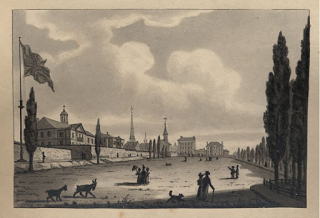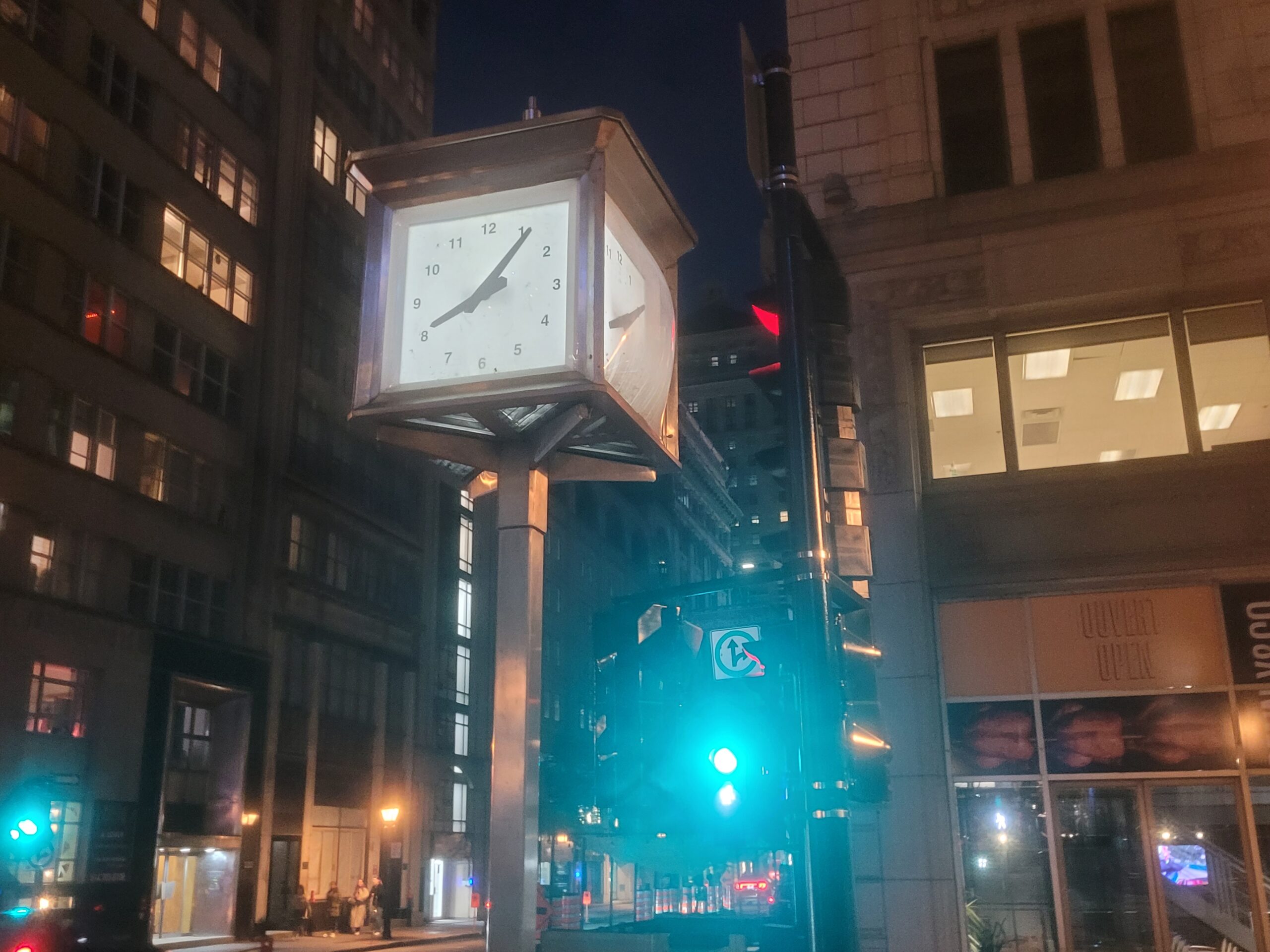While noted for their historical charm and timekeeping abilities, some of Montreal’s clocks are reputed to be haunted. Most of Montreal’s haunted clocks are located on St. James Street, an area associated with the extreme desecration of French colonial cemeteries by various financial corporations.
Welcome to the fifth installment of the Haunted Montreal Blog! Released on the 13th of every month, the September edition focuses on research we are carrying out into the old dungeon that lurks below Place Vauquelin in Old Montreal. Originally part of Montreal Prison, the jail cells are rumoured to be haunted by criminals long-since executed on the site.
We are also pleased to announce a special new tour for the Hallowe’en Season, currently in development!
Public Ghost Walks and private bookings are also available for both Haunted Downtown Montreal and Haunted Mountain. We also have a Tripadvisor page to enable our clients to provide feedback and reviews.
Haunted Research
Place Vauquelin is a picturesque square in historic Old Montreal that overlooks a storied military field, the Champ-de-Mars. Tourists often linger here, snapping photos by the beautiful fountain and reading the historical plaques on City Hall and the Old Courthouse. A set of staircases leads people down to the Champ-de-Mars.
What the visitors are oblivious to is a dark secret: lurking just below the square lies an old dungeon, a series of creepy jail cells that once housed Montreal’s most wretched and miserable prisoners, including those awaiting execution.
It is the site of the first Montreal Prison, a notorious jail where inmates were locked up in dangerous and unsanitary conditions. The prison also hosted live executions, where cheering crowds on the Champ-de-Mars witnessed criminals being hanged from a scaffold erected in front of the prison wall. The old jail cells are presently off-limits to the public and are rumoured to be haunted, possibly by ghosts of criminals long-since executed.
The inaccessible jail cells are presently overseen by the city’s Finance Department, which is based in the old courthouse. According to rumours, many city workers avoid the old dungeon because of the horrible feelings produced while inside the cells, including shortness of breath, a sense of claustrophobia, and feelings of fear and dread. Paranormal cold spots are also reported to materialize in certain cells, where the temperature can drop rapidly without warning. Muffled sounds can sometimes be heard in the jail, including the of clanking chains and rough, disembodied voices murmuring incomprehensibly. Maintenance staff have been known to avoid the area whenever possible, and access to the old jail cells is strictly limited by the city’s administration. Looking at the history of the site, the first structure built was a house for Jesuit priests in 1692, during the New France era. At the time, a rudimentary French prison was located on the north-west corner of Notre-Dame and Saint-Laurent. When the British took over the city in 1760, they seized the Jesuit’s property and converted it into a House of Detention in 1768. In 1803, a fire damaged the building and plans were made to erect a new prison.
By now Montreal’s population was bursting. The old stone walls from the New France era were demolished and a new field called the Champ-des-Mars was laid out. Named after the Roman God of War, Mars, the field was designed for military drills, leisurely promenading, and large public gatherings. In 1808, to the south of this field, construction began on a new jail. Designed by Joseph Courcelles (dit Chevalier), Montreal Prison opened its doors to inmates in 1811.
Prisoners included vagrants, prostitutes, citizens awaiting trial, convicts serving sentences and condemned criminals contemplating their scheduled executions.
Executions were very popular in Montreal and under British Law, hangings were meant to take place at the site of the jail. The Champ-de-Mars was seen as the absolute best place in the British Empire to witness a hanging, on account of the large field and sloping geography, and Montreal’s citizens were treated to a total of 44 hangings during the prison’s brief existence. Families would often pack a picnic lunch and bring the children to teach them about the value of obedience.
The executions began in April, 1812, when one D. McDougall was sentenced to be hanged after having been caught stealing in a shop. His body was “given over to anatomy”. As the years passed, others were hanged for crimes such as burglary, shoplifting, horse stealing, forgery, larceny, rape, and murder. Some of the executions raised eyebrows, such as that of a 13 year old boy named B. Clement, who was hanged in 1813 for stealing a cow, or in 1817 when one Monsieur Gendron dropped from the gallows for “sacrilege”.
The final execution at Montreal Prison occurred at around 10 a.m. on Friday, August 30, 1833. The star attraction was Adolphus Dewey, a man who had murdered his young wife, Euphrasine Martineau, in a fit of jealousy. After slashing her wrists and throat with a razor, Adolphus fled to the United States. He was soon arrested and brought back to Montreal, where he was promptly thrown into the dungeon of Montreal Prison. He awaited trial in chains for four months before being found guilty of murder.
In Montreal Prison, Adolphus was also chained up as he awaited his inevitable execution. He spent his final days, shackled in chains, praying and reading his Bible. He accepted a religious visitor, an American evangelist named Nancy Towle, who wanted to assure his salvation. Adolphus explained to her that because he had repented to God, he would be soon reunited with his beautiful wife, Euphrasine, in Heaven. Nancy Towle recorded his words and her thoughts for posterity in a document titled Some of the Writings and Last Sentences of Adolphus Dewey.
For his execution, Adolphus asked to wear a nice black suit and he requested that the constable hold up a copy of his last words. On the scaffold, Adolphus gave a rousing speech where he apologized to the citizens, accepted responsibility for his crimes, told the spectators that he had found God, and implored them to pray for his soul.
As a grim finale, when he dropped from the scaffold, Adolphus’ neck did not snap. Instead, he twisted and contorted in a tight noose, gasping and frothing at the mouth, for a full four minutes before finally expiring. It was the most popular execution in Montreal’s history and witnessed over 10,000 people in attendance.
Despite its popularity with citizens with live executions, Montreal Prison could also be described as a corrupt place. For example, in 1817 a party of affluent fur traders who belonged to the Nor’Westers were arrested and put in the prison. Known as the “Nabobs of the North”, the fur merchants used political connections and vast amounts of wealth to ensure lavish parties were hosted inside the jail until their associates were freed. There were also rumours that bribery could help with escape, and the Jailer and his son were known to take advantage of incarcerated prostitutes for their sexual gratification.
The conditions inside Montreal Prison were especially wretched and dreadful. The overcrowded jail stank and was infested with vermin. In the summer, it was stifling hot, whereas in the winter the prison was barely heated. Freezing winds and drifting snow whistled through broken panes, making the jail extremely cold in the winter. Inmates were forced to sleep in bare cells on the floor, sometimes on a bed of filthy straw, with an inadequate number of blankets. Prisoners awaiting trial or execution were chained to the wall while they slept. Food consisted of only bread and water, with a rare treat of watery broth containing bits of mysterious meat on Sundays and holidays.
Prisoners were also treated inhumanely. According to History of The Montreal Prison by Rev. J. D. Borthwick, disobedient inmates were forced into “the dark cell” for an extended period, a type of solitary confinement in complete blackness. Other prisoners were branded on the hand with a hot iron in the shape of a crown. During this painful torture, criminals had to cry out “Long live the King” three times before the red hot iron was pulled off their blistering skin. If it was a soldier being branded, the end of the iron had letters instead of a crown, with BC standing for “Bad Conduct” and D for “Desertion”.
Other popular forms of punishment were meted in public, directly across Notre Dame Street, at the base of Nelson’s Column. The column was erected in 1809 as an homage to British naval hero Admiral Horatio Nelson. Montreal’s citizens could often enjoy a spectacle, at the southern base of the monument, designed to humiliate criminals who had been found guilty of lesser crimes.
The Common Hangman, who lived in Montreal Prison, was known to whip criminals and rebellious prisoners on this spot with a cat-o-nine-tails, a type of whip with nine strands designed to inflict the maximum amount of pain. Victims were lashed 39 times each, in the name of tradition.
Authorities would also restrain certain prisoners in a pillory and invite citizens to throw garbage at them, including the horse droppings that littered Place Jacques Cartier, then a bustling marketplace. This public retribution was seen as a good way to collectively punish and shame criminals while simultaneously discouraging others from committing the same crime.
By 1835, Montreal Prison was starting to deteriorate. The building began to crumble and with severe overcrowding, conditions on the inside were worsening. It reached a point of crisis in December, when the emaciated, frozen corpse of an almost-naked man was discovered in a cell one morning. The Jailer identified him as one of the prisoners: John Collins, a starving and malnourished vagrant, who had actually frozen to death in Montreal Prison one cold December night.
A Grand Jury was immediately assembled to examine the issue. After investigating, they issued a damning report about the Montreal Prison, noting that the jail was falling into ruins after only 27 years of existence and that the conditions inside were utterly appalling. The report noted that the food was inadequate, the prison was not properly heated in the winter, inmates were crammed into freezing cells at night with no beds, and there were only 54 blankets for 84 prisoners and many of them lacked clothing, wearing nothing but rags. Prisoners awaiting trial or execution were also kept in chains. Not only was the prison miserable and overcrowded, but the report also noted that the Jailer and his sons took sexual advantage of the 37 prostitutes who were locked up at the time.
In 1836, Sainte Marie Prison (later re-named Pied-du-Courant) was erected to the east, near the shoreline at Saint Mary’s Current. The old Montreal Prison was converted into a House of Industry, a place where vagrants could work. However, in 1837 the building was again pressed into service as a jail when a rebellion by Les Patriotes generated excessive amounts of prisoners.
In 1838, Montreal Prison was closed permanently as a jail. For a few years it was used to headquarter Artillery Officers, and in 1846 the prison was finally demolished to make way for the new Palais de Justice. During the demolition, it was decided to preserve the old jail cells to serve as a foundation for the new courthouse and a public square, initially called Place Neptune, on the eastern portion of the old jail.
Today, the old dungeon and its storied cells lurking just below Place Vauquelin are strictly off-limits. It is difficult to obtain any information from city authorities about the forbidden area. While official City of Montreal archivists and guides often claim to have no knowledge of any hauntings, sometimes one of them will relay a rumour they have heard. As such, it is difficult to speculate exactly who or what may be haunting the old dungeon cells of Montreal Prison.
For example, the mysterious cold spots may be related to the starving vagrant, John Collins, who froze to death in the dungeon on one frosty December night in 1835. As for the disembodied murmuring voices, these are extremely difficult to place, but could be connected with the prayers of Adolphus Dewey, who may not have being accepted into Heaven to be reunited with his dear wife, Euphrasine. Indeed, many spectators who witnessed his execution felt that his prolonged and torturous death was evidence of God’s displeasure and that it was a case of poetic justice. Could the ghost of Adoplhus Dewey haunt the old cells, praying for a retribution that will never come? The paranormal activities could also be related to the dozens of other criminals who were hanged at the prison, such as B. Clement, the 13 year old boy found guilty of stealing a cow.
One thing is certain, more research is needed into the exact nature of the hauntings in the cells to gather more details to try and make more specific connections. At the time of this writing, Haunted Montreal is trying to gain access to the old dungeon of Montreal Prison, thusfar with no success.
However, a recent announcement from City Hall suggests things may be about to change. In July, 2015, the City of Montreal put out a call for bidders for archeological services at Place Vauquelin. Plans are afoot for an archaeological dig in the area, to be done in conjunction with repairing the foundations of City Hall.
City spokeswoman Valérie De Gagné explained: “The archeologists will survey the archeological traces that remain, and will sift the soil where they are found…This will allow them to learn more about the activities that took place in this location over time.”
While it is unknown what exactly the archaeologists will discover, with Montreal Prison’s deranged history and rumours of paranormal hauntings in the old cells, expectations are high that the workers may unearth a lot more than they bargained for! Whether or not the old dungeon and its cells will finally be made accessible to the public once the work is complete is still unknown.
Whatever the case, Haunted Montreal will continue to monitor the situation closely and will keep our readers updated as the archaeological dig progresses.
Company News
Haunted Montreal’s public season is in full swing and ghost walks are also available to private groups!
Private tours can be arranged for groups of 10 or more people and are subject to availability. For more information, please contact us at info@hauntedmontreal.com.
For the public season of Ghost Walks, here are the details of all upcoming performances:
Friday, September 18 @ 8 pm…..Haunted Mountain
Friday, September 25 @ 8 pm…..Haunted Downtown Montreal
Sunday, September 27 @ 8 pm….Haunted Downtown Montreal *** New Date ***
Sunday, September 27 @ 8 pm….Haunted Downtown Montreal *** New Date ***
Friday, October 2 @ 8 pm…………Haunted Mountain
Friday, October 9 @ 8 pm…………Haunted Downtown Montreal
Saturday, October 10 @ 8 pm……Haunted Mountain
Sunday, October 11 @ 8 pm……..Haunted Downtown Montreal
To book a Ghost Walk in the public season, please see 2015 Tours for details. If you have attended a ghost walk, please feel free to write a review on Tripadvisor, which helps Haunted Montreal promote its tours.
For the 2015 Hallowe’en Season, Haunted Montreal is pleased to announce a brand new Ghost Walk! Currently top secret and in development, the new Ghost Walk will take place on the following dates:
Friday, October 16 @ 8 pm
Saturday, October 17 @ 8 pm
Sunday, October 18 @ 8 pm
Friday, October 23 @ 8 pm
Saturday, October 24 @ 8 pm
Sunday, October 25 @ 8 pm
Friday, October 30 @ 8 pm
Saturday, October 31 @ 8 pm
Full details will be announced on October 1st, including how to buy tickets, so stay tuned!
Lastly, if you have witnessed anything paranormal in Montreal or if you have a local ghost story to tell, please get in touch by emailing info@hauntedmontreal.com.
Thank you for reading the Haunted Montreal Blog! Don’t forget to sign up to our mailing list if you want to receive the blog on the 13th of every month!
Coming on October 13th: The ghost of the McLennan Library. Persistent rumours at McGill University suggest the 6th floor of the McLennan Library is haunted. The ghostly apparition of an elderly man who wears a strange old coat is known to float quietly above the floor, sometimes towards students who are deep in a book or librarians stacking the shelves. The apparition is known to stop behind a person and stare intently at them until he is noticed. When the startled person reacts, whether verbally or physically, this ghost is known to simply disappear. There is very little information as to who this apparition is or why he is haunting the 6th floor of the library. The concrete Brutalist structure dates to 1969, but it was built on the grounds where an elegant 19th-century mansion once stood. Named “Dilcoosha”, a Hindustani word meaning “The Heart’s Delight”, it was originally the residence of Jesse Joseph, a prominent Montreal financier who died in 1904 at age 86. Could it be him who haunts the library?













It’s a creepy place! Too much torture and suffering happened in that place. I just saw on an article that many died in a prison cell.